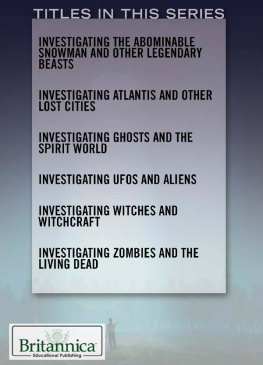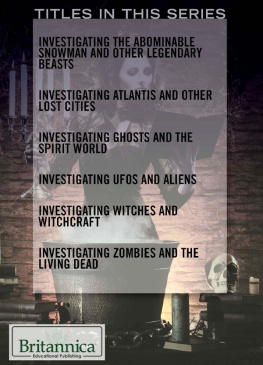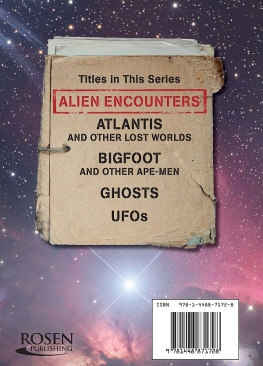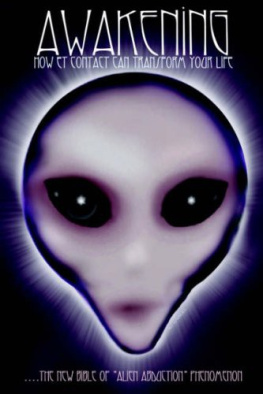
Published in 2015 by Britannica Educational Publishing (a trademark of Encyclopdia Britannica, Inc.) in association with The Rosen Publishing Group, Inc.
29 East 21st Street, New York, NY 10010
Copyright 2015 The Rosen Publishing Group, Inc., and Encyclopdia Britannica, Inc. Encyclopdia Britannica, Britannica, and the Thistle logo are registered trademarks of Encyclopdia Britannica, Inc. All rights reserved.
Distributed exclusively by Rosen Publishing.
To see additional Britannica Educational Publishing titles, go to rosenpublishing.com.
First Edition
Britannica Educational Publishing
J.E. Luebering: Director, Core Reference Group
Anthony L. Green: Editor, Comptons by Britannica
Rosen Publishing
Hope Lourie Killcoyne: Executive Editor
Shalini Saxena: Editor
Nelson S: Art Director
Brian Garvey: Designer
Cindy Reiman: Photography Manager
Library of Congress Cataloging-in-Publication Data
Shea, Therese, author.
Investigating UFOs and aliens/Therese Shea.First edition.
pages cm.(Understanding the paranormal)
Includes bibliographical references and index.
ISBN 978-1-62275-852-4 (eBook)
1. Unidentified flying objectsJuvenile literature. 2. Human-alien encountersJuvenile literature. I. Title.
TL789.2.S53 2015
001.942dc23
2014021040
Photo credits: Cover, p. 1 Photobank gallery/Shutterstock.com; pp. 45 Albert Ziganshin/Shutterstock.com; p. 6 National Radio Astronomy Observatory; p. 8 Rex Features via AP Images; p. 10 NASA/JPL/University of Arizona; p. 11 Science & Society Picture Library/Getty Images; p. 12 Apic/Hulton Archive/Getty Images; pp. 15, 36 Science Source; p. 16 Encyclopdia Britannica, Inc.; p. 17 Patrice Marty/Fotolia; pp. 1819 AFP/Getty Images; p. 21 Joe Raedle/Hulton Archive/Getty Images; p. 22 Barry King/WireImage/Getty Images; p. 25 National Institute of Standards and Technology; p. 27 Popperfoto/Getty Images; p. 29 AP Images; p. 30 Science Source/Photo Researchers/Getty Images; p. 31 SPL/Science Source; p. 34 Mary Evans/Ronald Grant/Everett Collection; p. 37 Universal Pictures/courtesy Everett Collection; p. 39 Lucasfilm/Entertainment Pictures/ZUMAPRESS.com; p. 40 Ralph Crane/The LIFE Picture Collection/Getty Images; interior pages background images iStockphoto.com/Kivilvim Pinar, iStockphoto.com/mitja2.
CONTENTS
I n April 2014, four people in Orlando, Florida, saw an object with red and green lights streak downward across the night sky. It passed behind a building, soared upward again, stopped in midair, and then turned. One of the witnesses was a pilot who claimed that no man-made aircraft could move like that at the speeds observed. What did these people see? A trick of the light? A classified government aircraft? An actual alien spacecraft?
Many people have reported seeing unusual objects like this in the sky. Whether life exists on other planets or not, the idea of unidentified flying objects (UFOs) and aliens has long excited and fascinated people on Earth. The presence of aliens on or beyond our planet has never been proven, but some people continue to believe in, look for signs of, and listen to stories about encounters with alien life.
Why are people so interested in alien life? Perhaps it is because now that we know how huge the universe really is, it seems possible that Earth is not the only life-supporting planet. Even among the often skeptical scientific community, there are some advocates for keeping an open mind about extraterrestrial life.

Aliens are often depicted like this, with large heads and eyes shaped like almonds. This most likely comes from literature on alien life.
T he word alien is a popular word for an extraterrestrial life-form, or a being that originated beyond Earth. No one knows if extraterrestrial life exists or ever existed, but some scientists think that it is possible. The branch of biology concerned with extraterrestrial lifefrom microscopic organisms to intelligent beingsis called exobiology or astrobiology. Scientists in this field consider the conditions necessary for life, how it evolves, how to detect alien life-forms, and the environments in which they might live, whether in our own solar system or on any of the numerous planets orbiting other stars.

Radio telescopes like this one in Virginia are capable of seeking out extraterrestrial signals from deep within outer space. However, nothing has been detected yet.
EXTRATERRESTRIAL LIFE
The precise requirements for life are not known. All living things on Earth are based on the element carbon and need water for chemical reactions. Hydrogen, nitrogen, phosphorous, sulfur, oxygen, and other elements are also essential. However, if alien life-forms exist, they might be very different from any living thing on Earth. Such life-forms might be difficult to detect or even recognize as life.
At a basic level, living things must be made of atoms that bond to form a variety of molecules at the temperatures in their environment. They probably require a liquid (water or perhaps ammonia, hydrogen cyanide, or liquid hydrocarbons) for chemical reactions. The environment would have this liquid at or near the surface. Life-forms would also need sunlight or another energy source, protection from ultraviolet radiation, and probably an atmosphere.
Extraterrestrial intelligence is one step further than extraterrestrial life. It means life from another world that is capable of thinking and working toward a purpose. Work in the field of astrobiology has provided some evidence that evolution of other intelligent species in the Milky Way Galaxy is not impossible.
MOVE OVER LITTLE GREEN MEN
Many peoples concept of alien life is that of little green or gray beings with large heads and huge eyes. These ideas come from books and films, and these aliens resemble life-forms we know wellpeople. At least one scientist suggests that people are imagining extraterrestrial intelligence all wrong.

Just as Earth has life-forms that have adapted to their differing environments in different ways, alien life-forms might have features that are better suited to different surroundings.
Dr. Maggie Aderin-Pocock envisioned one way alien life could have adapted to a planet similar to Jupiter. She hypothesized that silicon-based aliens could look somewhat like floating jellyfish and survive on sunlight and chemicals. They might not necessarily be intelligent enough to make contact with Earth, though. Aderin-Pocock also reminds people that aliens on other worlds might have previously existed but became extinct before human life evolved.
EXPLORATIONS
Space exploration has been an important part of the search for extraterrestrial life. Unmanned probes have visited every planet in the solar system, plus many moons, asteroids, and comets. Places in the solar system that seem most likely to have harbored lifemost likely microbesnow or in the past, include Mars, Jupiters moon Europa, and Saturns moon Enceladus. All three have, or once had, liquid water at or near the surface. Saturns moon Titan, which appears to have lakes of liquid methane, is also of great interest.















